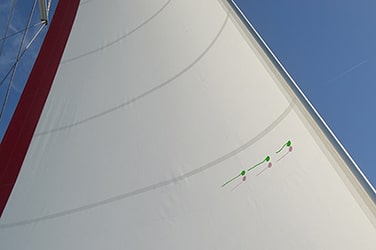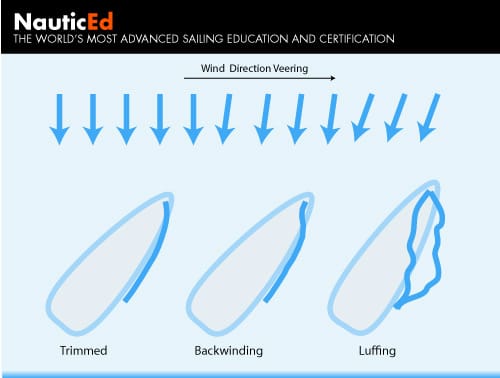
This article is an excerpt from NauticEd’s online FREE Basic Sail Trim Course, an interactive online sailing course for beginner to intermediate sailors to learn the basics of sail trim. Or if you want to learn more, upgrade to the Skipper Course Bundle to become a competent sailor!
You can learn to sail and improve your sailing with NauticEd, the international leader in sailing education.
Lifts and Knocks in Sailing

Figure 2.3-1 Sailboats Trimmed, Backwinded and Luffing
Above, see the wind changing for each boat on a port tack. The luffing boat on the right needs to bear away from the wind in order to keep the sails filled due to a wind direction change that is now coming more from the front of the boat. This is called a knock i.e. they are knocked downwind away from their desired upwind heading or destination.
In other words, if the wind direction changes to come more from the front of the boat forcing you to bear away then it is a knock (no matter what tack – port or starboard).
Conversely – if the wind direction changes to come more from the beam (side) of the boat this will then allow you to turn more toward the wind (and thus probably more toward your destination). This is called a lift – “you are lifted towards your destination”. It does not matter which tack you are on – port or starboard for it to be called a lift or knock. It is based on how the wind changes in direction.
Interestingly enough, if a boat on one tack gets knocked, (turned away and more downwind of their destination) the same boat can take advantage of that bad situation by tacking over to the opposite tack. On the opposite tack, the wind shift is called a lift because it allows the boat to turn more towards its destination.
Many times then, it is a good idea to tack your boat if you experience a knock but keep in mind that the knock may be temporary. Each time you tack, you lose a little time and so chasing the wind can cost you a race. Watch instead the heading of other boats ahead of you to see if the lift/knock holds. As you get really good at sail trim, however, there won’t be any sailboats ahead of you – right?
2.4.1 Veering and Backing
These are technical terms for how the direction of the wind is changing.
A veering wind means it is changing to a new direction that is clockwise from its current direction. For example, if the wind was out of the North-East and changed now to come out of the East, then by definition the wind would have “veered”.
Backing is the opposite of veering. For example, if the wind was out of the North-East and changed now to come out of the North, then by definition the wind would have “backed”.
In the image at the top of this page – is the wind veering or backing when going from the left side of the page to the right?
Putting the above together, if you’re heading upwind on a port tack, a veering wind would mean a knock. e.g. the wind in the image at the top is veering and the boat was knocked. A backing wind would mean a lift. On a starboard tack, a veering wind would mean a lift, and a backing wind would mean a knock.
Learn Basic Sail Trim for FREE...
A FREE 1-2 hour course that teaches how to work with sails to get your boat moving. The free Basic Sail Trim Course is for any aspiring sailor as well as experienced sailors wanting to learn more. Or, consider upgrading to the Skipper Course Bundle to become a fully competent skipper!
